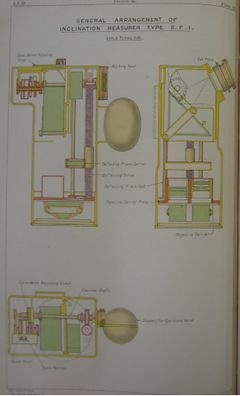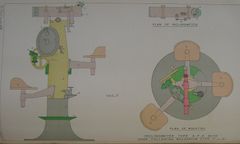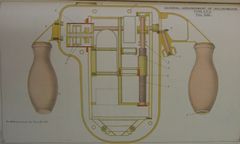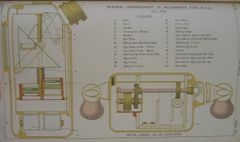Horizontal Angle Measurer
The Horizontal Angle Measurers were a family of inclinometers produced by Barr and Stroud for fire and torpedo control.
S.F. 1

Invented by Lieutenant Richard for gun control purposes, the S.F. 1 was a very compact, hand-held device able to measure and indicate on a scale drum angles from 0 to 100 arc minutes in steps of 10 arc seconds amenable to visual interpolation. The first two were ordered from Barr and Stroud at the end of 1917.
The user would hold the device in his right hand and use his thumb on the working head to bring two features into alignment horizontally.[2]
I do not yet understand the explanation offered:
To adjust for coincidence, there is a coincidence slide at the top of the instrument, by means of which the gearing to the scale drum from the counter shaft can be disconnected; with the scale drum at 0, unclutch and revolve the working head until coincidence is obtained, then clutch up again.
The device was compared in trials aboard Ramillies to the Langley Inclinometer Mark II and found to be easier to work and could generate readings more frequently. The S.F.1 was easier to look into, especially under battle conditions, as it had a rubber eyeguard and was not as sensitive to the position of the observer's eye.
S.F. 2

In 1918, one of these three-man pedestal mounted units was being manufactured for use in Hood. The crew sat on adjustable seats:
- Seat "T" for the observer
- Seat "Z" for the trainer
- Seat "S" for the hand following mechanism operator
A rubber eyeguard and focussing ring made it suitable to sustained long-range use. The device could be switched between 7 and 14 power on an angular field of 3 degrees "with a strip 15 feet high". [4]
Coloured glass shades could be inserted by milled head "A": grey, red, yellow or plain. The eyepiece was angle downward 60 degrees as in Barr and Stroud's rangefinders for comfort. Lever "H" permitted it to be kept on for elevation, with a finger rest "G" for comfort. The observer looked at right angle to the target, permitting correction of elevation to not force him to crane his neck. Window "L" Halving adjustment head "F". Instrument's coincidence adjusting head not shown on the plate. "D" is inclinometer working head for making the cut, also working scale drums "E" and coupling rod "M" to a Hand Following Mechanism T.L. 2.
The device could measure from 0 to 70 arc minutes in steps of 5 arc seconds, passed down in units (0 to 841). The trainer faced the target and observed it through Service pattern telescope "N", using handwheel "Q" to train the pedestal. A bearing transmitter on the pedestal sent this data to the Torpedo Transmitting Station.
The observer pressed pedal "V" when he had a cut, which worked the cut indicator "P" in the centre of the T.L. 2 "K". This signaled the hand working operator to make sure he had matched the unit for transmission before pressing the pneumatic and electrical push "R?" which presumably works a shutter or light on the receiver in the T.T.S.. Lens "O" ensured the units were precisely read.
Apparently, the whole was on the torpedo control rangefinder and Evershed system which are not shown. The instrument and the torpedo control R.F. would first be placed on the object by the control officer in the principal torpedo control position and then it would transmit so that the RF could follow.[5]
In 1919, some modifications were made. The seat for the hand-following operator had to be made smaller to fit within Hood's aloft position, and the training of the instrument was made to also drive a bearing transmitter to reduce the number of men required. A foot pedal worked the shutter on the bearing receiver in the torpedo T.S.. No repeat receivers were provided, requiring a telephone to be used to the T.T.S. in order to place the instruments in step. A gun trainer's telescope of variable power 3 to 9 assisted the trainer. The inclinometer itself was variable from 7 to 14 power.[6]
S.F. 3


In 1918, this existed in plan form only as a proposed improvement on the S.F. 1.[9]
It would reduce the maximum angle to be measured from 100 minutes to 50 and provide a halving adjustment. The scale drum would be graduated in tenths of a minute rather than sixths, and a light rail mounting and belt provided for, as with a navigational rangefinder. They would require a drum-type slide rule of 7 inches diameter, which would be mounted on a rail nearby. The same double "strip coincidence" separating line in the Langley automatic inclinator being provided for gunnery would be adopted.
In the images, window "D" at the top of the instrument provided illumination for reading through window "E". Working head "T" allowed the coincidence to be sought, and a small key in the right handle, "Z" provided the halving adjustment.
With a magnification power of 9.5, the angular field was 4.5 degrees, circular. By 1920, it had been altered to measure from 100 arc minutes to zero.[10]
Footnotes
- ↑ Annual Report of the Torpedo School, 1918. Plate 118.
- ↑ Annual Report of the Torpedo School, 1918. pp. 171-172.
- ↑ Annual Report of the Torpedo School, 1918. Plate 121.
- ↑ Annual Report of the Torpedo School, 1918. p. 173. Editor does not understand the quoted portion about a strip.
- ↑ Annual Report of the Torpedo School, 1918. p. 174.
- ↑ Annual Report of the Torpedo School, 1919. pp. 117-8.
- ↑ Annual Report of the Torpedo School, 1918. Plate 119.
- ↑ Annual Report of the Torpedo School, 1918. Plate 120.
- ↑ Annual Report of the Torpedo School, 1918. p. 172.
- ↑ Manual of Gunnery (Volume III) for His Majesty's Fleet, 1920. p. 30.
See Also
Bibliography
- Admiralty, Gunnery Branch (1917). Handbook of Torpedo Control, 1916. C.B. 302. Copy No. 141 at The National Archives. ADM 186/381.
- H.M.S. Vernon. Annual Report of the Torpedo School, 1917. Originally C.B. 1474. Copy 7 at The National Archives. ADM 189/37.
- H.M.S. Vernon. Annual Report of the Torpedo School, 1918. C.B. 1527. Copy 143 at The National Archives. ADM 189/38.